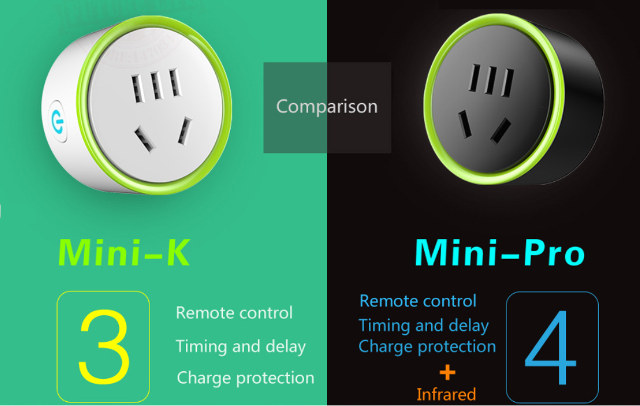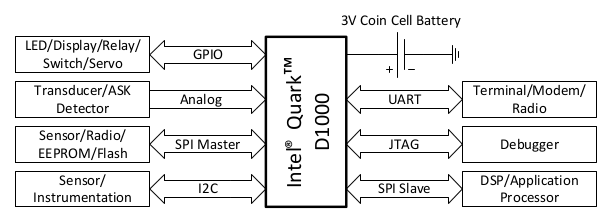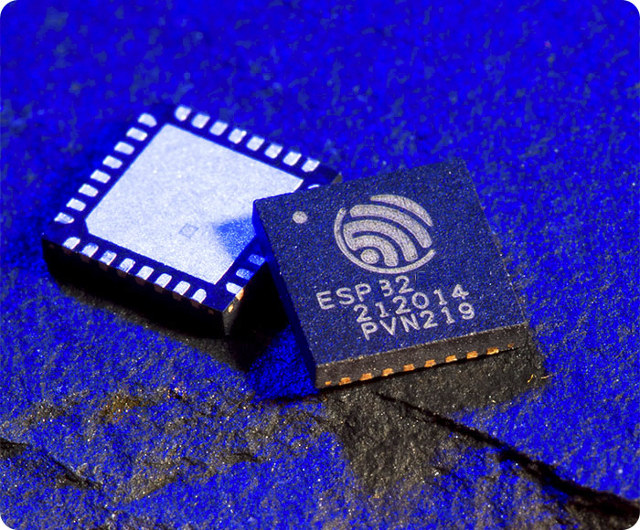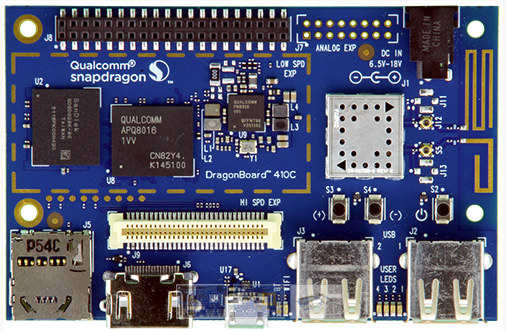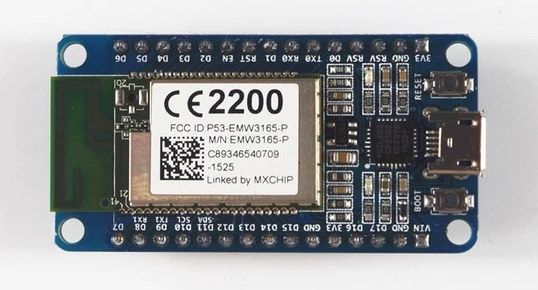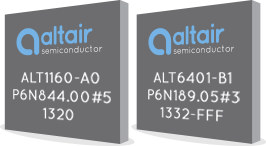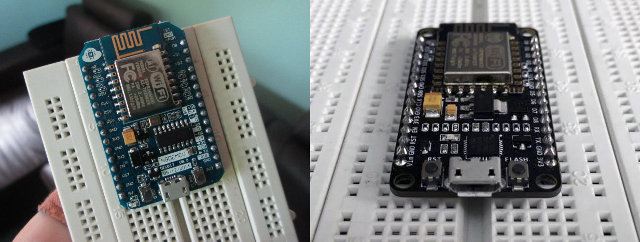ESP8266 WiFi modules are very popular in the maker community, but so far I have not seen it in any devices myself, until I saw a tweet from @EspressifSystem about a Mini K smart socket. A search on Aliexpress lead me to two devices made by Konke, who also made Kankun KK-SP3 WiFi socket, with Mini K and Mini Pro smart sockets. Both models has basically the same features, except Mini-Pro adds infrared support: Connectivity – 802.11 b/g/n Rated Voltage – AC 100-240V 50/60Hz Rated Power – 2200 Watts Rated Current – 10A Charging Protection: Yes Misc – Power button, Infrared (Mini Pro model only) Plug – China / AU plugs Dimensions – 5.1 diameter x 2.7 cm (V0 grade PC material) Weight – 70 grams Both devices support on/off timers, cyclical delays and charge protection (turns off when devices are charged) with the Android or iOS app. I understand […]
Intel Unveils Three New Micro-controllers for IoT: Quark D1000, Quark D2000, and Quark SE
Intel’s subsidiary, Wind River, has recently announced two operating systems for the Internet of things with Rocket RTOS and Pulsar Linux supported respectively by Quark MCUs, and Intel Atom processors, as well as some ARM SoCs. But it’s not the only “IoT” announcement made by Intel in the last week, as I found out via EETimes that the company also unveiled three new Quark SoCs, namely Quark D1000, and Quark D2000, and Quark SE. Intel Quark D1000 Contrary to previous Quark processor and the upcoming D2000 and SE processors, D1000 is not compatible with x86 instructions set, and features the following: 32-bit Harvard CISC CPU @ 33 MHz with single cycle barrel shifter, two cycle multiplier, multi-cycle divider, integrated 32-bit timer, programmable interrupt controller, and JTAG debugger. 128-bit wide 32 kB code flash and 8 kB ROM 32-bit wide 8 kB SRAM and 4 kB data flash Osciallators 20-33 MHz […]
Espressif ESP32 Dual Core SoC Features Faster WiFi, Bluetooth 4.0 LE, and More Peripherals
Espressif teased us about a successor to ESP8266 a few months ago that would support both WiFi and Bluetooth Low Energy, and John Lee, working for Espressif Systems, has now sent a letter to ESP8266 developers announcing the new wireless SoC with two Tensilica L108 cores and called ESP32. Espressif ESP32 key improvements over ESP8266: Faster WiFi – Wifi has been upgraded to support HT40 speed (144.4 Mbps) and has a new RF architecture to simplify the application schematics Bluetooth Low Energy and Classic Dual core processor – 2x Tensilica L108 processors clocked at up to 160 MHz Low Power Mode Improvements – ADC conversions, level thresholds, etc.. can now be performed in deep sleep Peripherals – Capacitive touch, ADCs, DACs, I2C. UART, SPI, SDIO, I2S, RMII, PMW, etc… but no USB. More RAM – ~400 KB on-chip RAM Security – Hardware accelerated AES and SSL, and more undisclosed improvements. […]
Wind River Introduces Free Cloud-based Operating Systems for IoT Applications
After Google Brillo operating system was officially launched last week, another company has announced free operating systems for IoT. What’s peculiar is that the company is Wind River a vendor of commercial operating systems whose typical business model is to sell licenses for their operating systems and fees for their development services. Nevertheless, the company has now introduced Wind River Rocket real-time operating system, and Wind River Pulsar Linux operating system. Both OSes will interface with the company’s Helix Cloud software-as-a-service (SaaS) products, which is probably how the company intends to monetize their work, on top of customization services. Wind River Helix App Cloud is currently made of three products: Helix App Cloud cloud-based development environment for building IoT applications Helix Lab Cloud cloud-based virtual hardware lab for simulating and testing IoT devices and complex systems. Helix Device Cloud cloud-based platform for managing deployed IoT devices and their data. Some […]
Qualcomm DragonBoard 410c Board Now Supports Windows 10 IoT Core
Microsoft announced Windows 10 IoT Core for Raspberry Pi 2 and Minnowboard MAX boards a few months, and now the company has added a new ARM board to their Windows 10 IoT program with the soon-to-be-available Qualcomm DragonBoard 410c development board compliant with 96Boards specifications. Windows 10 IoT Core for DragonBoard 410c adds support for onboard WiFi and Bluetooth, as well as DirectX graphics on top of features already supported on the Raspberry Pi 2. To get started, you’ll need a computer running Windows 10, and follow DragonBoard’s Winfows 10 IoT Core guide. I assume most people familiar with Linux operating systems won’t suddenly jump ship to run a Windows operating systems, but Windows developers who got used to work with Visual Studio may be more comfortable with Microsoft’s environment. Out of curiosity, I’ve checked out if anybody had done any project with Windows 10 IoT core, and was surprised […]
$10 WiFiMCU Board is a NodeMCU Clone Based on EMW3165 Module
Yesterday I wrote a short tutorial for NodeMCU board, and one visitor mentioned WiFiMCU board that has a similar form factor as NodeMCU, and while it is more expensive at about $10 on Aliexpress or Ebay, it is also more powerful and provides more I/Os thanks to its EMW3165 module including an STM32 Cortex M4 micro-controller with 128KB RAM, 512KB flash, a Broadcom WiFi module, and 2MB SPI flash. WiFiMCU specifications: MCU – STMicro STM32F411CE Cortex-M4 microcontroller @ 100MHz with 128KB RAM, 512KB flash Storage – 2MB SPI flash WiFi – Broadcom 802.11 b/g/n RF Chip: Modes – Station, Soft AP and Station+Soft AP Security – WEP, WPA/WPA2, PSK/Enterprise 16.5dBm@11b, 14.5dBm@11g, 13.5dBm@11n Receiver sensitivity – -87 dBm 2x 15-pin headers with 17x GPIO Pin 3x UARTs 5x ADC, 1x SPI, 1x I2C, 1x USB SWD debug interface 11x PWM Misc – Boot and Reset buttons Power Supply – 5V via […]
Altair FourGee LTE Chipsets Promise 10 Years of Connectivity with AA Batteries for IoT Applications
Connectivity achieved with GSM,. 3G or LTE (4G) cellular networks is great for long distances, but usually costs and power consumption are too high for IoT or M2M communications, which explains why there are competing long range low power WAN standards such as Sigfox, LoRA or Weightless. Altair Semiconductor introduced two new LTE SoCs, namely FourGee-1150/6410 and FourGee-1160/6410 a few months ago, supporting respectively LTE Cat-0 and Cat-1 connectivity, and promising up to 10 years of battery life on AA batteries for smart meters, wearables, security alarms, city lightings, etc… Altair FourGee-1150 and FourGee-1160 key features and specifications: Processor – Multiple MIPS M5150 “Warrior” MCU cores LTE Connectivity FourGee-1150 LTE Release 12 Category-0 (1Mbps / 1Mbps), software upgradeable for supporting Release 13 features Integrated VoLTE/IMS/OTA-DM functionality FourGee-1160 LTE Release 11 Category-1 (10Mbps / 5Mbps), software upgradeable for supporting Releases 12 and 13 features Integrated VoLTE/IMS/OTA-DM with HD voice functionality Software […]
Getting Started with NodeMCU Board Powered by ESP8266 WiSoC
Since ESP8266 is now so popular, I’ve recently bought a NodeMCU board to try it. I selected this board because the latest version of the board is breadboard-friendly, integrates a USB to serial chip, and it can be powered by a simple USB to micro USB cable. I also noticed a ESP8266 tutorial with NodeMCU firmware by SwitchDoc Labs the other day (using ESP-12 and Adafruit Huzzah), which I applied to my NodeMCU board, but since I encountered a few issues, I decided to report my findings, and write my own little getting started guide to switch on/off LED and GPIOs using a web interface. NodeMCU v0.9 and NodeMCU v1.0 If you are going to purchase a NodeMCU board it’s important to know there are two official versions: NodeMCU v0.9 with ESP-12 module NodeMCU v1.0 with ESP-12E module The main complain about NodeMCU v0.9 is that while it fits on […]


